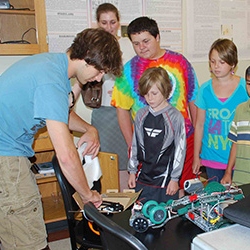The Solution is All in Your Head
The story of robotics hasn’t always been a happy one, with countless tales of robots causing an end to humankind However, Dr. Delphine Dean and Dr. David Kwartowitz have put a new spin on the classic tale. Their Creative Inquiry project in the bioengineering department focuses on helping people by using neural signals to control machines.
It all started as a student-led project, dubbed MindBot, that was an attempt to show the public just how far neural technology had progressed and what could be done using cost-effective equipment. But for these bioengineering students the project also provided an outlet for their creative juices to flow. Dr. Dean mentioned, “What makes this project really fun to work on as an advisor is that the whole process was extremely student driven; all the ideas originated from the students, which is why I think the project was so original and ‘out of the box.'” The team drew up a concept design that used cranial electromyograms (EMGs) to direct a two-wheel robot to move forward, backward or to rotate.
The Mindbot was a great success! The team received a grant and is now working on the second phase of the project: to develop a device that’s wirelessly controlled?through a neural headset?to navigate a maze while overcoming physical obstacles.
The project’s potential is vast and far reaching. Joe Connolly, a senior student on the team, explained, “Through this experience, I was allowed to show my project to kids ranging from elementary school to college. CI served as a conduit to allow me to share my passion my the younger generation.” This type of technology could someday be used in anything from helping mobilize quadriplegics to mind-controlled video games to effortless driving.
Team members not only get the satisfaction of knowing that their product may someday be used to help society, but they experience hands-on engineering in the fields of electrical and mechanical design, computer programming and system architecture. They also get a taste of how signal/image processing and psychological feedback work. Connolly commented, “With the help of my fantastic mentors, I had the freedom to work with a diverse team and explore an idea. I applied the concepts I learned through my college experience in a way that interested me the most.”
New team members aren’t expected to know the difference between a PIC and an ARM or how to handle segmentation faults, but if they’re a devoted student ready to learn more in a teamcentric environment, they are perfect for the team. Connolly summed it all up perfectly when he said, “The most rewarding thing I took away from the Creative Inquiry was showing other people the “cool” side of engineering – the side they may not realize exists.



